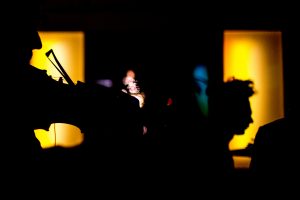By Ellen Røed
on the occasion of BEK’s 15th anniversary, December 2015
It was in the beginning of January 2000. Bergen’s newly started centre for electronic art barely managed to get online before they opened the doors for the art milieu. Motherboard, an artist group run by Amanda Steggell and Per Platou, was ready with Hot Wired Live Art, a project that would put BEK on the international map from day one. The paint was not dry, but there was already plenty of will to work at BEK, not to mention the 100 megabit network. And then there was the server. Accessing a server that was free from commercial interests was big for some of us in the wake of the internet childhood. All internet traffic goes via servers and the evil small capitalists of this time were therefore the server suppliers, small kings who ran web hotels and sold email accounts, and who had little sense of experimentation. At BEK, we got free server access and help to implement the functions we needed.
The vision of owning ones own server was perhaps the basic idea that, during the autumn of 1998, put Gisle Frøysland and Jørgen Larsson on the trail of what we would soon get to know as BEK. They wanted to create art where the audience could interact with the work over the internet. They wanted, for example, to light the tower at Lysverket and let the audience control the light themselves, something Gisle did in the autumn of 2000. For such work, a server was needed, that the artists could define and program themselves. Together with Trond Lossius, who had also arrived, they began the work to be able to send midi, and maybe even video and audio, to and from various applications over the internet, using the super server pl0t. At the same time, they refurbished 190 square meters in C. Sundtsgate 55, established an up-and-coming equipment park, created a number of discursive forums in the form of mailing lists, and made everything possible for BEK to be a proper laboratory.
Laboratory is perhaps also the most fitting word for the first project, Hot Wired Live Art. In the first two weeks of the new millennium, 16 artists gathered for an intense interplay of different media and expressions. They had warmed up on a lighthouse out in the open sea – with video projections on the lighthouse and high technology also there, to mark the transition to Y2K. Experimental digital popular culture had been Amanda Steggell and Per Platou’s focus since the mid-nineties, which had put them in touch with a rich and international network of artists. Choreographers, visual artists, musicians and theatre people, not to forget a fencing instructor, therefore gathered in C. Sundtsgate and realised this new laboratory, BEK. Sher Doruff and Niels Bogarts from Waag in Amsterdam brought with them Keystroke, a multi-user platform where different media were equated and could be connected to each other, in real time. With Keystroke we could jam, with sound, image and other signals, in networks that were both here and there, and thus invite the rest of the world along. BEK already had a basic attitude that art is first and foremost art. Talking about performing arts, music or visual arts was irrelevant, as the different expressions were basically built on the same foundation. Art was one, no matter what form one used. For BEK, art was also something that took place and lived in networks. Art was movement, which orients and moves independently of boundaries or physical distances. Different nodes needed to be connected so that an exchange of ideas and other forms of signals could take place. In other words, art was first and foremost something social, something that is best cultivated in meetings, in interaction, by letting different forces rub against each other, be touched, and influenced by each other.
En guard! Scott dela Hunta’s fencing chord triggered the cameras when it hit the opponent Leon Cullinaire’s white suit. Close-ups of their faces filled the walls. The images were captured by devices that transmitted them on the network and triggered audio and text. Slogans that the fighters had noted in advance flew over the projections in a verbal duel. “Equalize all media!” So big and so overall was the ideal. Because in digitized form, all media are the same. As data, they can be cross-linked and set up against each other, in real time. What comes out of the system can be fed back into increasingly complicated circuits. As Per Platou stated in one of the many texts that spread in the international community after Hot Wired Live Art: “I think I’m living in a constant world of loops and feedbacks, loops and feedbacks.”
Today, many of BEK’s server services have been shut down and the cloud kings are so powerful that no one bothers to speak out against them. Everyone are social and connected to each other online, all the time, and everywhere. Therefore, it may be difficult to understand how important these laboratories, that BEK has formed over the years, have been. But tonight’s fantastic programme testifies to the essential characteristic of BEK’s activities: That art production are social actions, and that electronic art activates the spaces, the connections, the meetings. Myriads of connections form the breeding ground for the artistic expressions that arise between or across digital media. Because, as Hot Wired Live Art demonstrated with such a great force: In networks you can cross-connect disciplines, actors, ideas and media, and play them with and against each other. In these meetings, new things arise. That is why interdisciplinarity continues to be more than a euphemism for the Bergen Centre for Electronic Arts.
 Bergen, 11. desember 2015: Bergen Elektroniske Kunstsenter feirer 15 års jubileum på Landmark. Foto: Eivind Senneset
Bergen, 11. desember 2015: Bergen Elektroniske Kunstsenter feirer 15 års jubileum på Landmark. Foto: Eivind Senneset